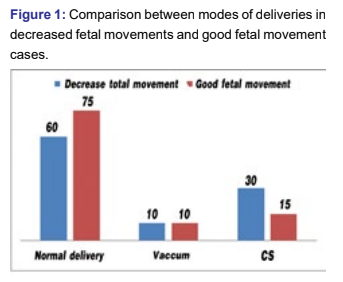Abstract
Introduction:
Fetal activity serves as an indirect measure of the fetus central nervous
system integrity and function. Regular fetal movement can be regarded
as an expression of fetal wellbeing. Maternal perception of decreased
fetal movement is associated with poor feto-maternal outcome.
This study is to find out feto-maternal outcome in cases of decreased
fetal movement, done by assessing fetal heart rate (FHR) correlating
with cardiotocography (CTG) and USG (ultrasonography) findings,
Apgar score and meconium in amniotic fluid.
Materials and method
This was a hospital based, prospective comparative study done in Patan
Academy of Health Sciences, Lalitpur, Nepal. The sample size was 200;
100 cases of decreased fetal movement versus 100 cases of good fetal
movement at same gestational age in weeks. Data processing was done
in SPSS version 20.0 (SPSS, Chicago, IL, USA) and calculated by chi-
square test. P value less than 0.05 was considered significant.
Results:
Significant difference was found in fetal kick chart counting. In the
decreased fetal movement group, 16% had oligohydraminos, 3% had
polyhydraminos and 5% had non reassuring CTG and 4% had abnormal
heart rate detected clinically. There was statistically significant difference
observed btween the two groups in labor induction, cesarean section,
meconium stain liquor, cord around the neck and different neonatal
morbidities.
Conclusion:
Decreased fetal movement is associated with poor fetomaternal
outcome. Improved vigilance, early identification, further evaluation
with CTG, USG and proper management of these pregnancies have
favourable pregnancy outcome.
References
Gynecol Scand. 2004; 83:818-26.
2. Sadovskey E, Ohel G, Havazeleth H, Steinwell A, Penchas S. The definition and the significance of decreased fetal movements.
ActaobstetGynecol Scand. 1983; 62:409-13.
3. Tveit JVH, Saastad Eli ,Stray-Pedersen B, Bordahi Per E, Flenady V, Fretts R.et al. Reduction of late stillbirth with the
introduction of fetal movement information and guidelines-a clinical quality improvement. BMC Pregnancy Childbirth. 2009;9:32.
4. Heazell AEP, Green M, Wright C, Flenady V, Froen F. Midwives’ and obstetricians’ knowledge and man agement of women presenting with decreased fetal movements. ActaObstetriciaet Gynecological. 2008;87:331-39.
5. Haws RA, Yakoob MYY, Soomro T, Menez EV, Darmstadt GL et al. Reducing stillbirths: screening and monitoring during pregnancy
and labor. BMC Pregnancy and Childbirth. 2009;9(Suppl1):S5.
6. Solt I, Divon MY. Fetal surveillance tests. In: Blazer S, Zimmer EZ, editor. The Embryo: Scientific Discovery and Medical Ethics.
Basel: Karger. 2005;pp.291–308.
7. Flynn AM, Kelly J, Mansfield H, Needham P, O'Conor M, Viegas O. A randomized controlled trial of non-stress antepartum
cardiotocography. Br J ObstetGynaecol. 1982;89:427–33.
8. Rayburn W, Greene J, Donaldson M. Nonstress testing and perinatal outcome. J Reprod Med. 1980;24:191–96.
9. Evertson LR, Gauthier RJ, Collea JV. Fetal demise following negative contraction stress tests. Obstet Gynecol. 1978;51:671–73.
10. Rayburn W, Zuspan F, Motley ME, Donaldson M. An alternative to antepartum FHR testing. Am JObstet Gynecol. 1980;138:223-26.
11. Rabinowitz R, Persitz E, Sadovsky E. The relation between fetal heart accelerations and fetal movements. Obstet Gynecol.
1983;61:16-28.
12. Lee CY, Drukker B. The no stress test for antepartum assessment of fetal reserve. Am J Obstet Gynecol. 1979;134:460-70.
13. Valentin L, Marsal K. Pregnancy outcome in women perceiving decreased fetal movement. Eur J Obstet GynecolReprod Biol.
1987;24:23-32.
14. Heazell AEP, Sumathi GM, Bhatti NR. What investigation is appropriate following maternal perception of reduced fetal
movements? Journal of Obstetrics and Gynecology. 2005;25(7):648-50.
15. Whitty JE, Garfinkel DA, Divon MY. Maternal Perception of decreased fetal movement as an indication for antepartum testing in a
low risk population. Am J Obstet Gynecol. 1991;165:1084-88.
16. Sherer DM, Spong CY, GhidiniA,Minior RK, Salafia CM. Decreased amniotic fluid Volume at <32 weeks of gestation is associated
with decreased fetal movements. Am J Perinatol. 1996;13:479-82.
17. Locatelli A, Zagarella A, Toso L, Assi F, Ghidini A, Biffi A. Serial assessment of amniotic fluid index in uncomplicated term
pregnancies: prognostic value of amniotic fluid reduction. J Matern Fetal Neonatal Med. 2004;15:233–36.
18. Baron C, Morgan MA, Garite TJ. The impact of amniotic fluid volume assessed intrapartum on perinatal outcome. Am J Obstet
Gynecol. 1995;173:167–74.
19. Sinha D, Sharma A, Nallaswamy V, JayagopalN ,Bhatti N. Obstetric outcome in women complaining of reduced fetal movements.
Journal of Obstetrics and Gynecology. 2007;27(1):41- 43.

